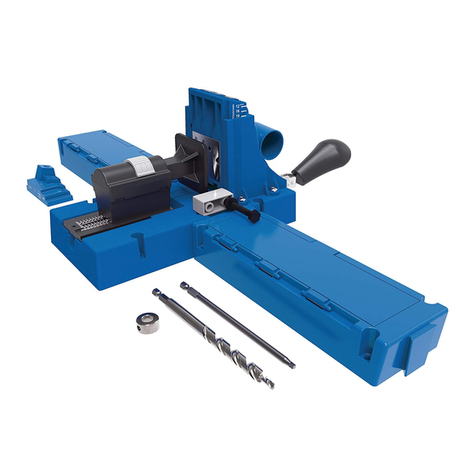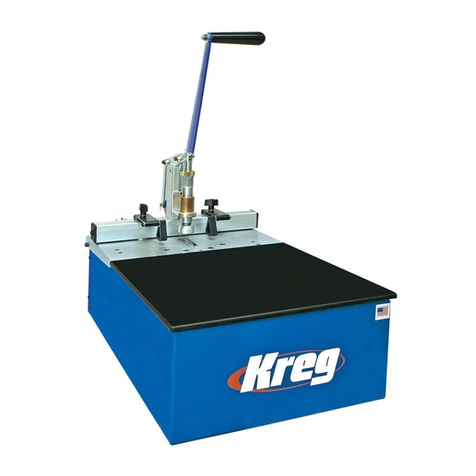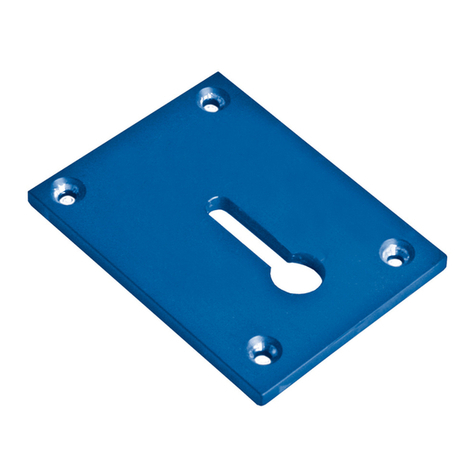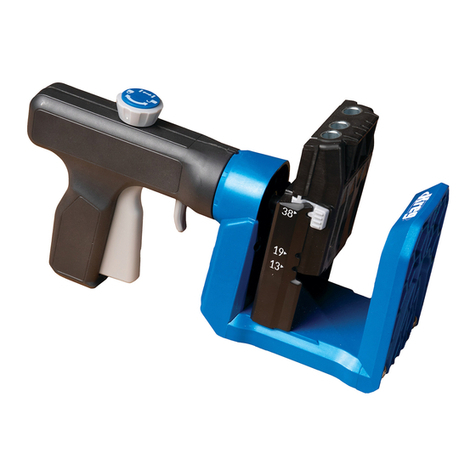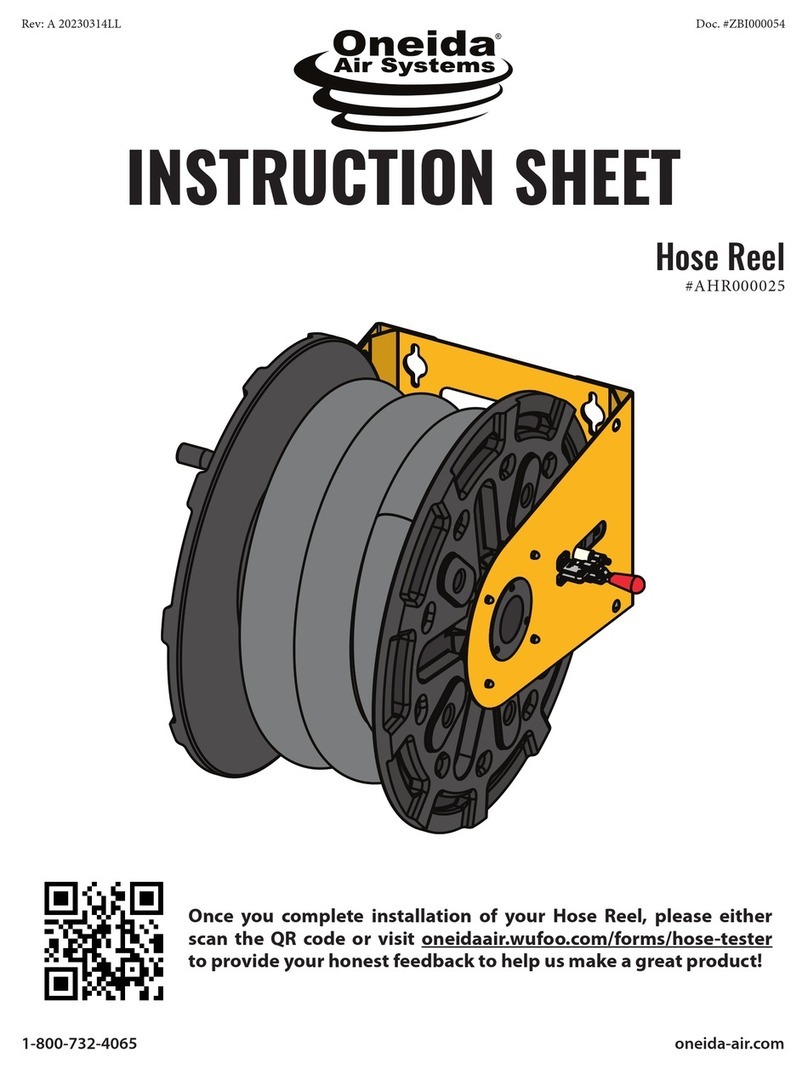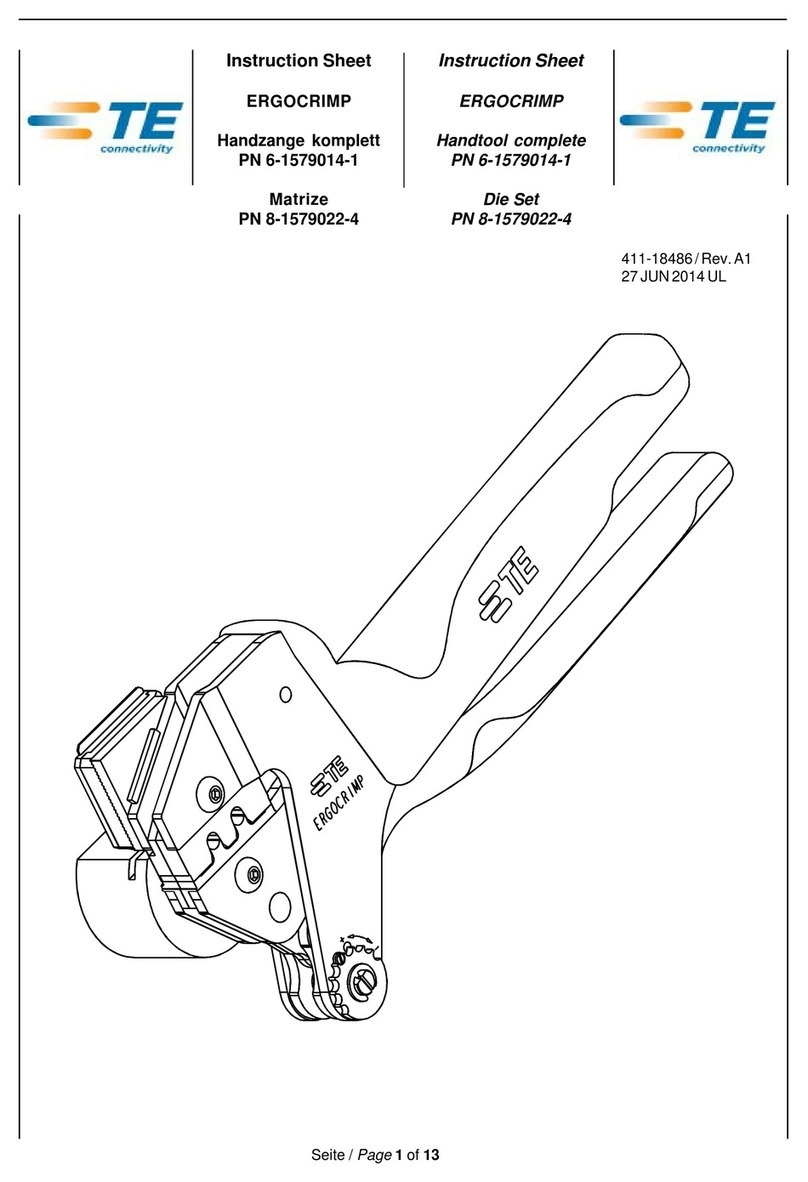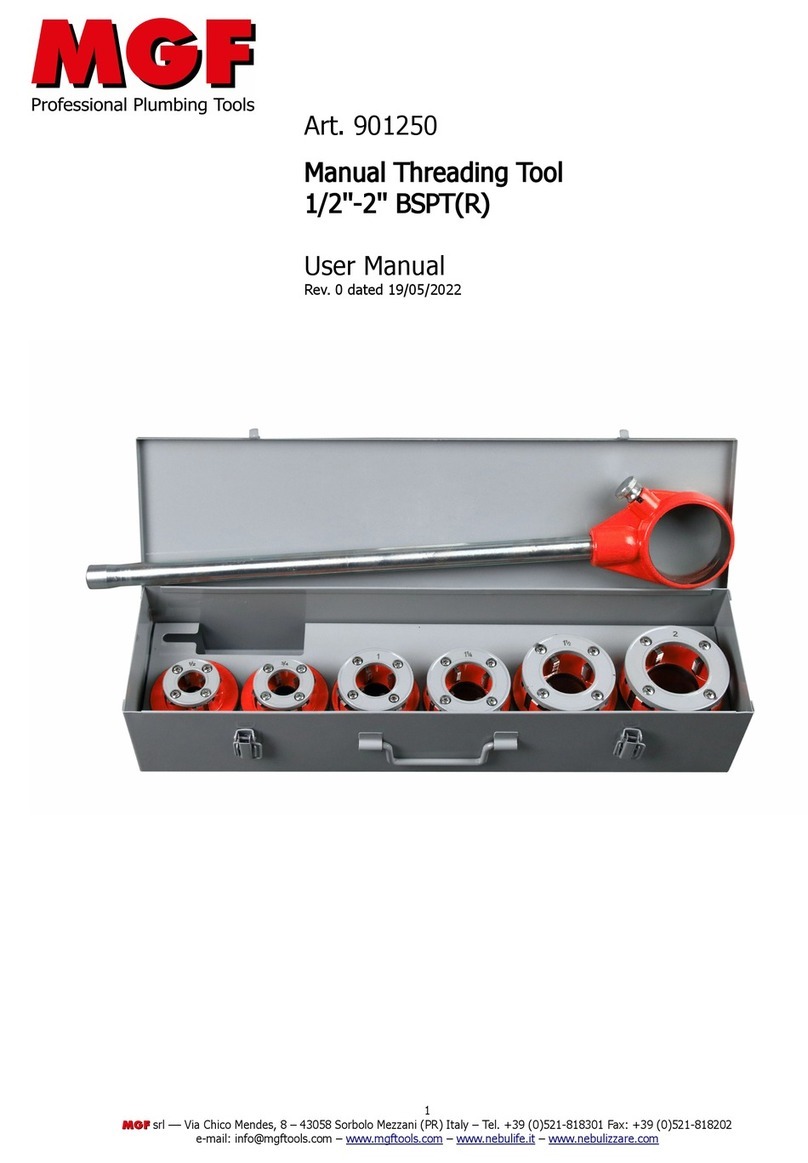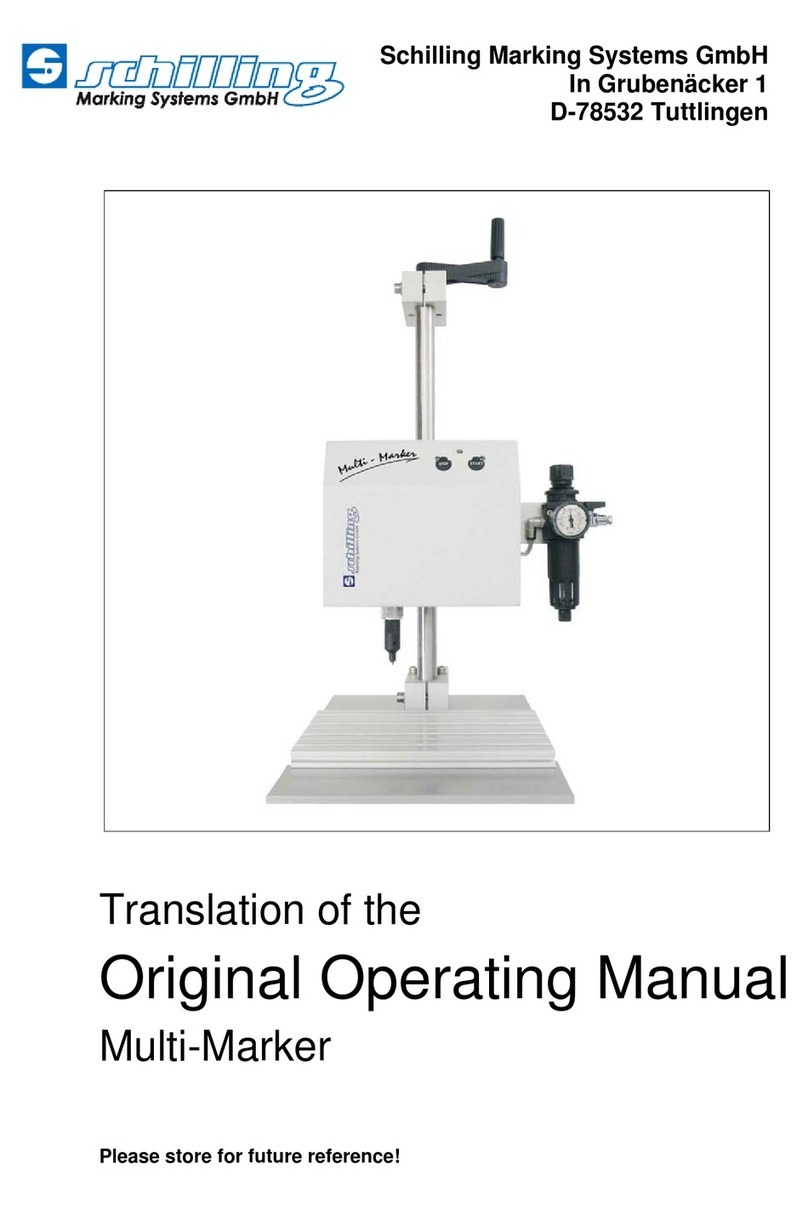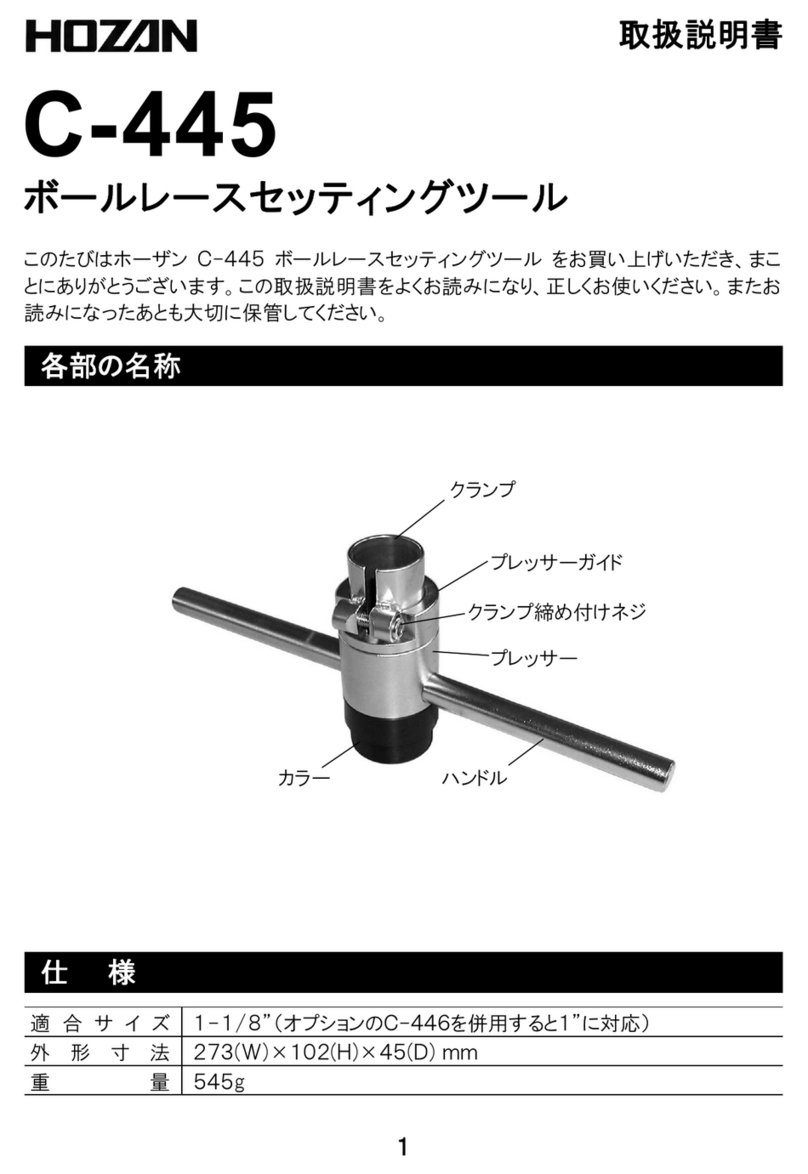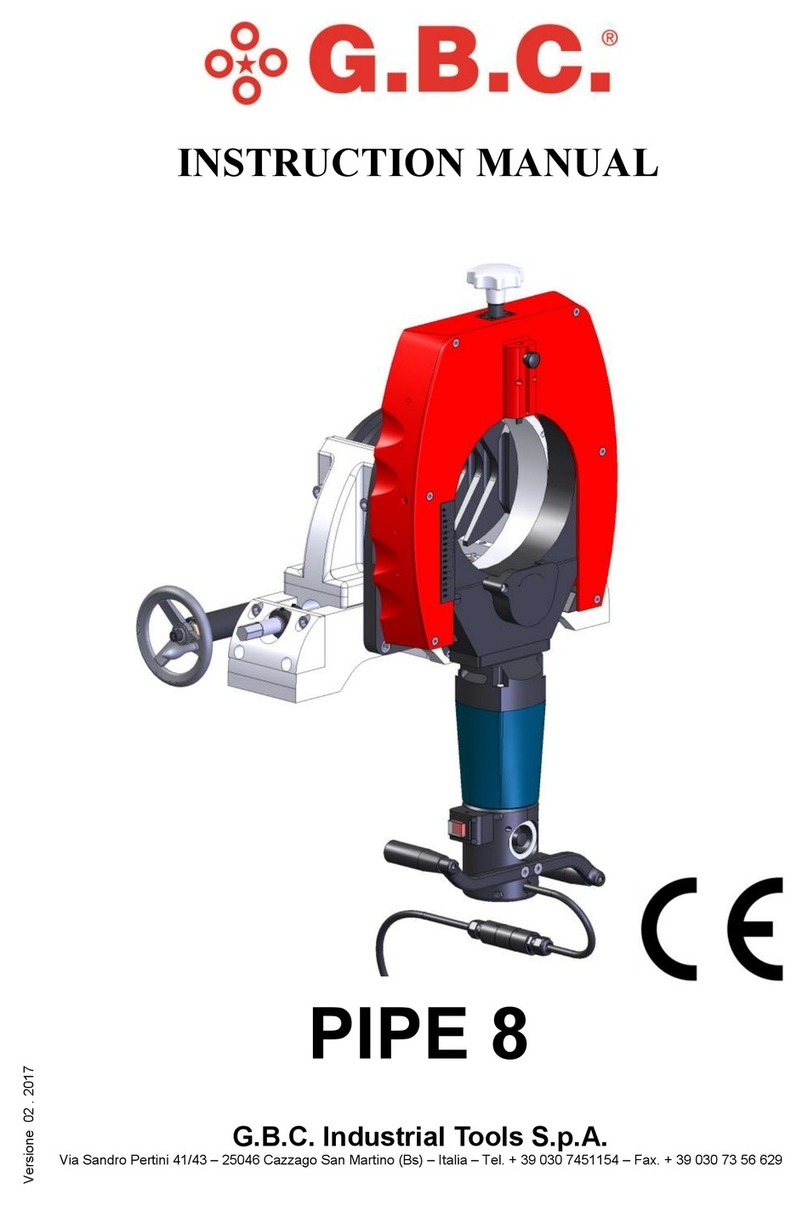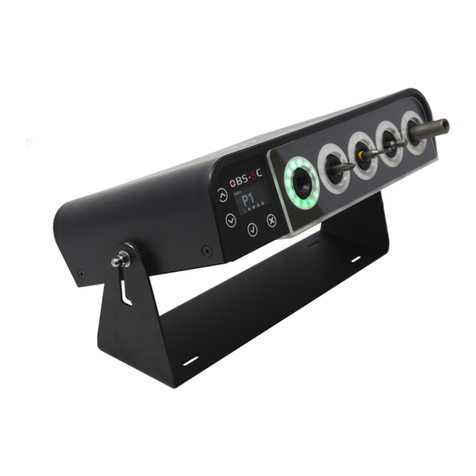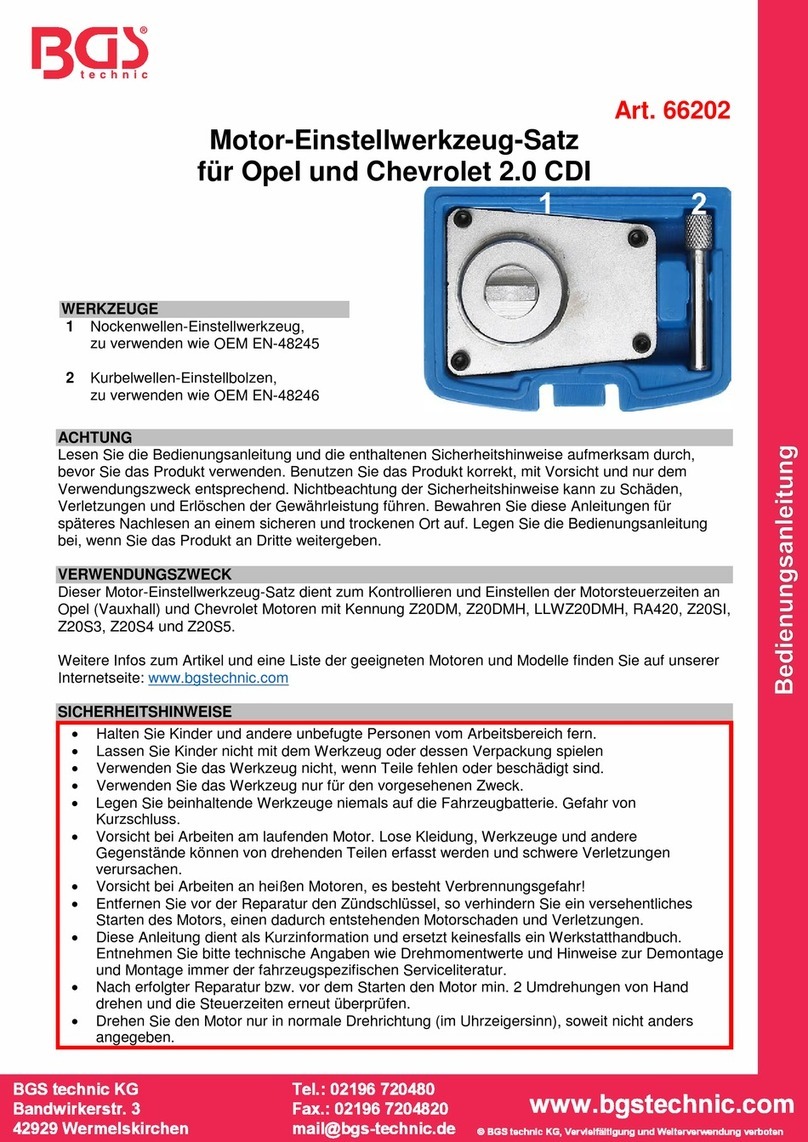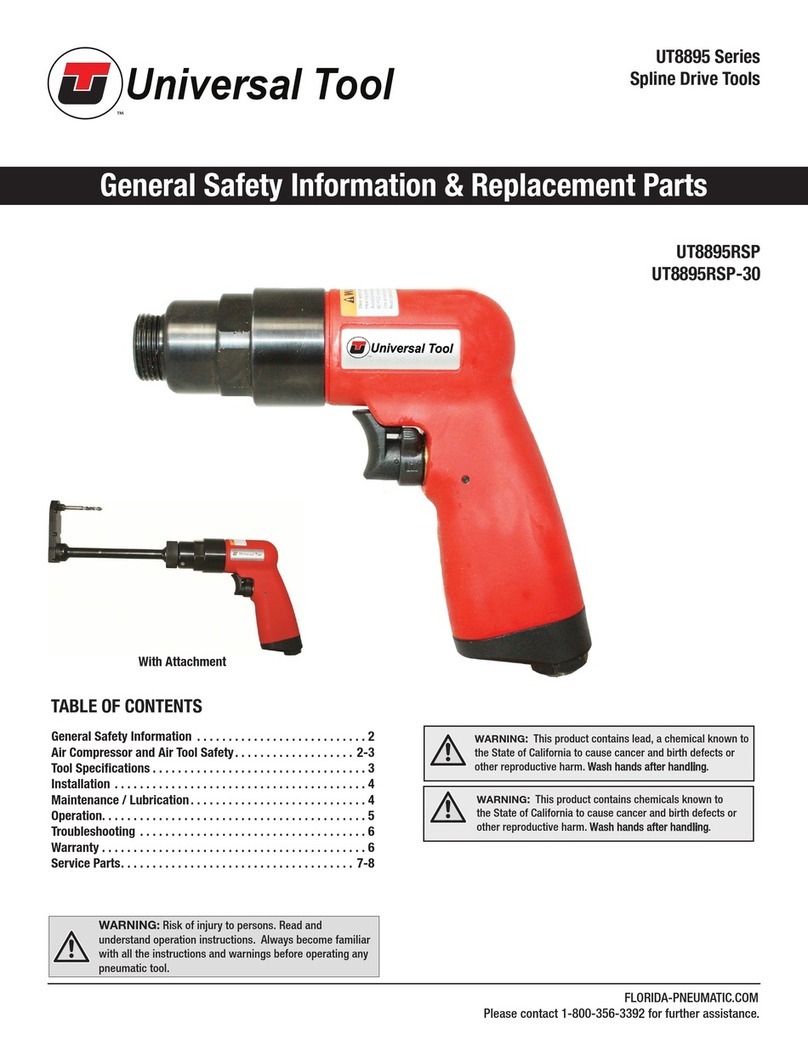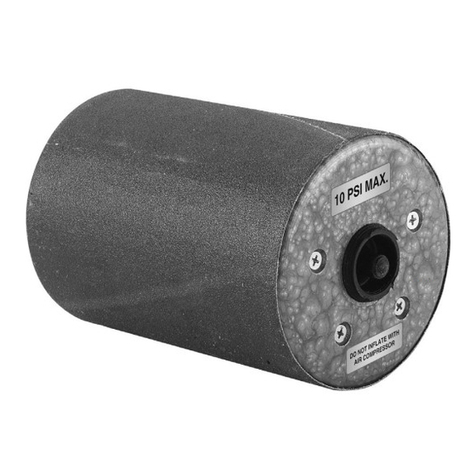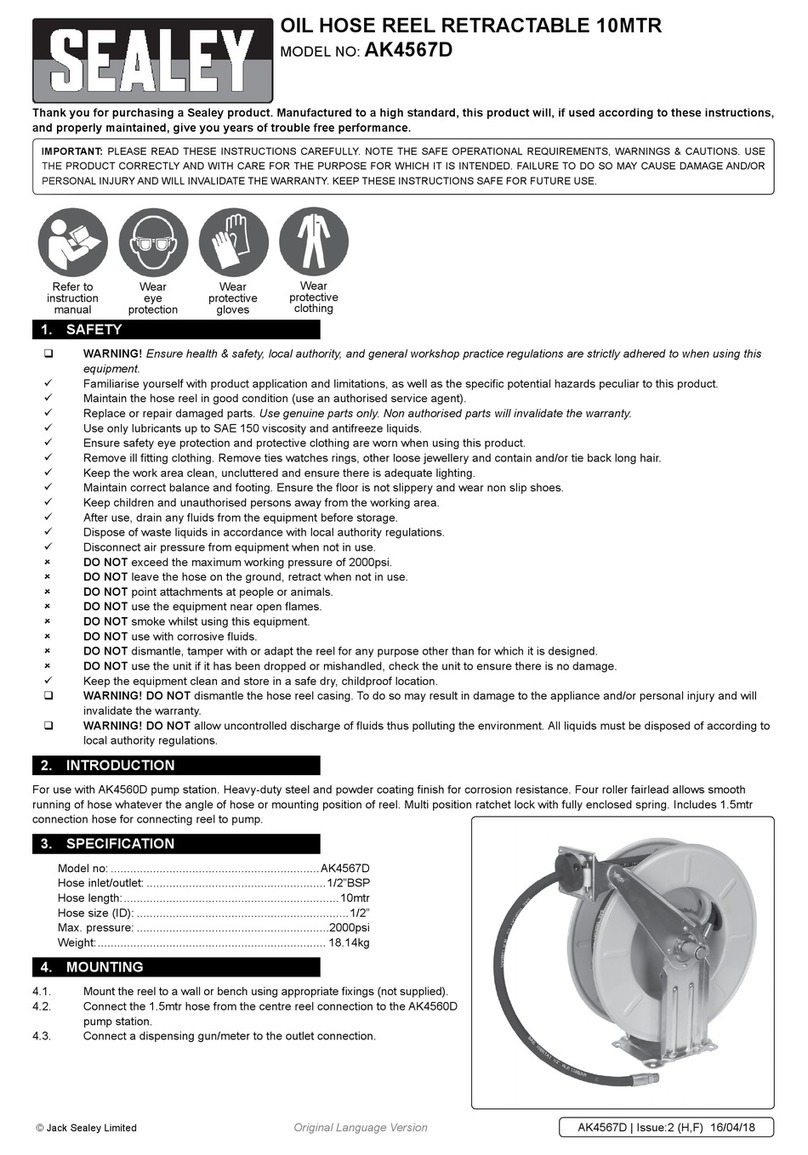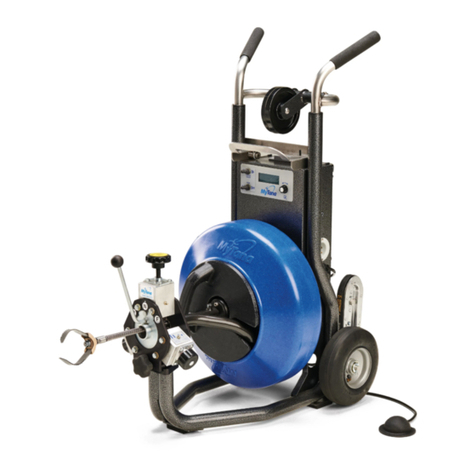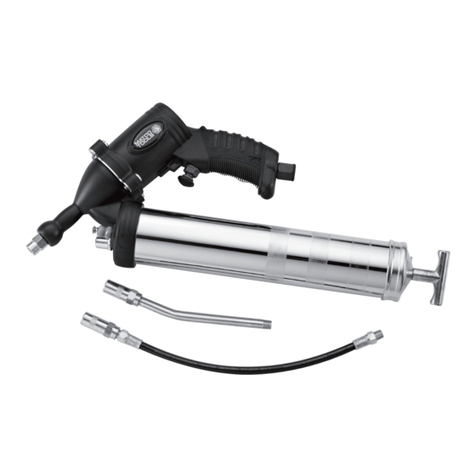Kreg DB55 Operating and maintenance manual

4-
FOREMAN
INSTRUCTIONAL MANUAL
DB55 Pneumatic/DB110 Electric Models
Electric Foreman
Item# DB110
Item# DB55
Pneumatic Foreman
Patents pending. Version 2005701
DB5305
The Blue Mark of Quality.
Note: Rockler may not carry all products and/or sizes listed in this vendor's publication
(29341)
(29341)
RTD10000270AA

4-
Table of Contents
1.
Congratulations on choosing a Kreg Foreman Semi-Automatic Pocket Hole Machine!
Be sure to read the instructions and the safety warnings completely before using this machine.
Table of Contents
TABLE OF CONTENTS 1
SAFETY GUIDELINES 2
PARTS DIAGRAM - DB110 3
PARTS DIAGRAM - DB55 4
ASSEMBLY INSTRUCTIONS - DB110 5
ASSEMBLY INSTRUCTIONS - DB55 6
DB110 (Electric Model) 7-10
General Operations/Maintenance 7
Adjusting the EZ DB Fence 8
Adjusting the Drill Bit Depth Stop/Clamping Pad Height/Safety Switch 9
Swing Stops/Changing the Drill Bit 10
DB55 (Pneumatic Models) 11-14
General Operations/Maintenance 11
Adjusting the EZ DB Fence 12
Adjusting the Drill Bit Depth Stop/Clamping Pad Height/Automatic Lubricator 13
Swing Stops/Changing the Drill Bit 14
Warranty 15
Attention:
As with all machinery, there are certain hazards involved with operation and use of the machine. Using
the machine with respect and caution will considerably lessen the possibility of personal injury. However, if
normal safety precautions are overlooked or ignored, personal injury to the operator may result.
This system was designed for certain applications only. Kreg strongly recommends that this
system NOT be modified and/or used for any application other than for which it was de-
signed. If you have any questions relative to its application, DO NOT use the Tools until you
have written Kreg Tool and we have advised you.

4- Safety Guidelines 2.
Safety Guidelines
Thank you for purchasing a KREG product. All products have been
designed to ensure safe and eȒcient operation when installed and used properly.
4-
Warning
Woodworking machines are dangerous and can cause personal injury if not used properly.
Read safety instructions and operating instruction for your machine completely before using products.
Using this system before understanding its safe and proper use could result in serious injury to the operator.
Failure to follow these rules may result in serious personal injury.
For your own safety, read instructions manual before operating the tool. Learn the tools application and limitations as well as
the specific hazards peculiar to it.
Keep all guards and safety devices in proper place while using these products.
Always wear safety glasses.
Keep hands well away from the pneumatic or mechanical clamp and rotating bit when operating machine.
Avoid awkward hand positions, where a sudden slip could cause contact with rotating bit. Never reach under the clamp pad
with either hand to hold down the workpiece.
Kickbacks
Beware of kickbacks; they can cause serious injury. A kickback occurs when the workpiece binds up while being drilled, causing
it to twist, jump, or become airborne.
To Avoid kickbacks:
Always use sharp drill bits.
Keep machine in proper alignment and good working condition.
Never perform any “free hand” drilling. Work must always be held securely against the table and fence.
Always support longer boards when drilling.
To avoid injury, never make adjustments while the machine is running.
Make sure machine comes to a complete stop before removing or securing workpiece, or workpiece angle.
Ground all tools. If tool is equipped with three-prong plug, it should be plugged into a three hole electrical receptacle. If an adapter is
used to accommodate a two-prong receptacle, the adapter lug must be attached to a known ground. Never remove the third prong.
Remove adjusting keys and wrenches. Form habit of checking to see that keys and adjusting wrenches are removed from tool before
turning it “on”.
Don’t use in dangerous environment. Don’t use power tools in damp or wet locations, or expose them to rain. Keep work area well-lighted.
Keep children and visitors away. All children and visitors should be kept a safe distance from work area.
Make workshop CHILD PROOF with padlocks, master switches, or by removing starter keys.
Don’t force tool. It will do the job better and be safer at the rate for which it was designed.
Use right tool. Don’t force tool attachment to do a job for which it was not designed.
Wear proper apparel. No loose clothing, gloves, neckties, rings, bracelets, or other jewelry to get caught in moving parts. Nonslip footwear is
recommended. Wear protective hair covering to contain long hair.
Secure work. Use clamps or a vise to hold work when practical. It’s safer than using your hand and frees both hands to operate tool. Don’t over-
reach. Keep proper footing and balance at all times.
Maintain tools in top condition. Keep tools sharp and clean for best and safest performance.
Follow instructions for lubricating and changing accessories.
Disconnect tools before servicing and when changing accessories such as bits, clamps, etc.
Use recommended accessories. The use of improper accessories may cause hazards.
Avoid accidental starting. Make sure switch is in “OFF” position before plugging in power cord.
Never stand on tool. Serious injury could occur if the tool is tipped or if the cutting tool is accidentally contacted.
Check damaged parts. Before further use of the tool, a guard or other part that is damaged should be carefully checked to ensure that it
will operate properly and perform its intended function. Check for alignment of moving parts, binding of moving parts, breakage of parts,
mounting, and any other conditions that may affect its operation. A guard or other part that is damaged should be properly repaired or replaced.
Never leave tool running unattended. Turn power off. Don’t leave tool until it comes to a complete stop.
Drugs, alcohol, medication. Do not operate tool while under the influence of drugs, alcohol or any medication.
Make sure tool is disconnected from power supply while motor is being mounted, connected or reconnected.

4-
DB110 Parts Diagram
3.
DB110 Electric Model
Part No. Description
DB110 M Electric Drill Motor
DB5252 Connecting Rod
DB5054 Clevis Pin & Nut
DB5215 Tool Plate
DB5002 Replacement Guide
DB5003 Guide Rod
FT4126 Depth Stop Lock Nut
DB5253 Depth Stop Adjusting Screw
DB5209 Operator Assembly
DB5247 Clevis & Cotter Pin
DB5214 Safety Switch
DB5208 Handle
Part No. Description
DB5055 Hand Grip
DB5232 Motor Mount
DB5207 Cabinet (2 Parts)
DB5210 Transfer Bar
DB5229 Hold Down Lock Nut
DB5230 Hold Down Adjustment Shaft
DB5244 Clamping Pad
DB5231 Clamping Tower
DB5251 EZ DB Fence
DKSS Swing Stop
DB5216 Safety Latch
DB5228 Hold Down Bolt
Electric
Drill Motor
Clevis Pin
& Nut
Connecting
Rod
Guide Rod
Safety Latch
Cabinet
Tool Plate
EZ DB Fence
Replacement
Guide
Operator
Assembly
Clevis &
Cotter Pin
Transfer Bar
Clamping
Tower Hand Grip
Handle
Hold Down Bolt
Hold Down Lock Nut
Hold Down Adjustment Shaft
Clamping Pad
Swing Stop
Safety Switch
Depth Stop Lock Nut
Motor Mount
Depth Stop Adjusting Screw

4- DB55 Parts Diagram 4.
DB55 Pneumatic Model
Part No. Description
DB5002 Replacement Guide
DB5003 Guide Rod
DB5004 Motor Mount
DB5006 Clamping Tower
DB5251 EZ DB Fence
DB5009 Connecting Rod
DB5010 Clamping Pad
DB5215 Tool Plate
DB5207 Cabinet (2 Parts)
DB5216 Safety Latch
DB5026 Operator Assembly
Part No. Description
DB5022 Handle
DB5052 Clamping Cylinder
DB5053 Air Drill Motor
DB5054 Clevis Pin & Nut
DB5055 Hand Grip
DB5065 3/8” Jacobs Drill Chuck
DB5066 Chuck Key for Item DB5065 (Not Shown)
DB5253 Depth Stop Adjusting Screw
FT4126 Depth Stop Lock Nut
DB5102 Automatic Oil Lubricator
DKSS Swing Stop
3/8” Jacobs
Drill Chuck
Motor
Mount
Clevis Pin
& Nut
Air Drill
Motor
Automatic Oil
Lubricator
Depth Stop
Adjusting Screw
Depth Stop Lock Nut
Swing Stop
Clamping Pad
Clamping Cylinder
Handle
Hand Grip
Clamping Tower
Operator Assembly
EZ DB Fence
Tool Plate
Replacement
Guide
Safety Latch
Cabinet Connecting
Rod
Guide Rod

4-
Assembly Instructions - DB110 Electric
5.
Semi-Automatic Electric Foreman DB110 Assembly
Entirely electric, no compressed air needed.
Motor rated at 3/4-HP and 8-amps
Assemble the Handle (Fig. 5A)
The Handle for the Foreman is disconnected for shipping purposes.
The handle is shipped with two nut and bolt sets installed finger tight
in the Handle and Operator Assembly.
1. Remove both nuts and washers from their respective bolts and
align the first set of holes in the Handle and the Operator Assembly.
2. Push the first bolt through the Handle and Operator Assembly and
attach the washer and nut.
3. Align the second set of holes in the Handle and the Operator
Assembly and push the second bolt through the Handle and
Operator Assembly and attach the remaining washer and nut.
4. Tighten both nut and bolt sets.
Attach the Mechanical Clamping Tower (Fig. 5B & 6B)
To attach the Mechanical Clamping Tower a bolt must be secured
that is located on the underside of the machine. This operation may
be performed with the machine placed on its side on a workbench to
more easily reach the bolt. Refer to figure 5B and 6B for assembly.
Location of the bolt is the same for electric and pneumatic models.
1. Remove all packing material from the Mechanical Clamping Tower
prior to attaching the Tower to the Fence.
2. The anchoring bolt for the Clamping Tower passes through the
EZ DB Fence and is held in position with a nut for shipping
purposes. Remove the Nut from the 5/16-18 Bolt and use a ¼”
Allen Wrench to thread the anchoring bolt into the bottom of
the Clamping Tower.
3. Align the Clamping Tower so it sits squarely on the EZ DB Fence
and tighten the anchoring bolt.
Connect the Clamping Linkage (Fig. 5C)
The Transfer Bars are disconnected from the Operator Assembly for
shipping purposes. You will need to attach each Transfer Bar to the
sides of the cam contained on the Operator Assembly.
1. Remove the 1/4” diameter X 3/4” long Clevis and Cotter Pin from
the Operator Assembly.
2. Align each of the Transfer Bars outside the cam on the Operator
Assembly.
3. Push the Clevis through the aligned holes and attach the Cotter Pin.
Fig. 5C
Align the Transfer Bars to the outside of the cam
contained on the operator assembly.
Fig. 5A
Fig. 5B
The anchoring bolt is accessed from under the machine.
Handle with bolts, washers, and nuts properly installed.

4- Assembly Instructions - DB55 Pneumatic 6.
Semi-Automatic Pneumatic Foreman DB55 Assembly
90-120 psi recommended -
Minimum compressor capacity of 5.3 cfm @ 90 psi
Assemble the Handle (Fig. 6A)
The Handle for the Foreman is disconnected for shipping purposes.
The handle is shipped with two nut and bolt sets installed finger tight
in the Handle and Operator Assembly.
1. Remove both nuts and washers from their respective bolts and
align the first set of holes in the Handle and the Operator
Assembly.
2. Push the first bolt through the Handle and Operator Assembly
and attach the washer and nut.
3. Align the second set of holes in the Handle and the Operator
Assembly and push the second bolt through the Handle and
Operator Assembly and attach the remaining washer and nut.
4. Tighten both nut and bolt sets.
Attach the Pneumatic Clamping Tower (Fig. 6B & 5B)
To attach the Pneumatic Clamping Tower a bolt must be secured that
is located on the underside of the machine. This operation may be
performed with the machine placed on its side on a workbench to
more easily reach the bolt. Refer to figure 5B and 6B for assembly.
Location of the bolt is the same for electric and pneumatic models.
1. Remove all packing material from the Pneumatic Clamping Tower
prior to attaching the Tower to the Fence. The Air Cylinder is
connected to the machine via the small diameter air supply line, be
careful not to twist or disconnect the air supply line during
assembly.
2. The anchoring bolt for the Clamping Tower passes through the
EZ DB Fence and is held in position with a nut for shipping
purposes. Remove the Nut from the 5/16-18 Bolt and use a ¼”
Allen Wrench to thread the anchoring bolt into the bottom of the
Clamping Tower.
3. Align the Clamping Tower so it sits squarely on the EZ DB Fence
and tighten the anchoring bolt.
Fill the Automatic Oil Lubricator (Fig. 6C)
The Automatic Oil Lubricator is void of Air Tool Oil for shipping pur-
poses. A 2-ounce bottle of air tool oil is provided with the machine
and should be used to fill the Lubricator. Operation of the Automatic
Oil Lubricator is discussed in the “ADJUSTMENTS” – “Automatic Oil
Lubricator” section of this manual.
1. Remove the Fill Cap of the Lubricator and add air tool oil to the
“MAX. OIL” line on the Lubricator.
2. Replace the Fill Cap in the Lubricator and tighten.
Handle with bolts, washers, and nuts properly installed.
Thread the anchoring bolt into the bottom of the
Clamping Tower.
Remove the Fill Cap and fill the Lubricator
to the “Max Oil” Line.
Fig. 6A
Fig. 6B
Fig. 6C
Fill Cap

4-
DB110 Electric - General Operation/Maintenance
7.
Semi-Automatic Electric Foreman DB110 Operation
Entirely electric, no compressed air needed.
Motor rated at 3/4-HP and 8-amps
GENERAL OPERATION (Fig. 7A)
To operate the Electric FOREMAN, first place a workpiece under the
clamping pad. Make sure that the clamping pad extends no more
than 1/8” above the workpiece in the unclamped state. If more than
a 1/8” gap exists, adjust the Clamping Pad to the correct height. See
the “ADJUSTMENTS” section – “Adjusting the Clamping Pad” for more
information. Secondly making sure all body parts and clothing are
safely away from the Clamping Pad, Drill Guide and Drill Bit, pull the
handle towards the work surface. This action will start the Drill Motor
and the mechanical action of moving the Handle will be transferred
to the clamping mechanism to hold the workpiece in position prior to
drilling. Continue to pull the Handle slowly toward the table surface
to complete the drilling cycle. Finish the drilling process by carefully
guiding the Handle back to the starting position. This will stop the
Drill Motor and release the Clamping Pad.
MAINTENANCE (Fig. 7B & 7C)
1. Keep motor clean. Like any electric tool the Electric FOREMAN
needs to be kept free of excessive wood chips and dust. Routinely
remove waste material from inside the cabinet or mount the
machine above an open stand that will not allow the waste
material to accumulate.
2. Lubricate Guide Rods. Periodically service the Guide Rods with
a dry film lubricant like Dri-Tool™ Lubricant from Empire
Manufacturing. A dry film lubricant will not collect wood chips
and dust and will extend the life of the Bearings and the Guide
Rods. See the “ADJUSTMENTS” section – “Changing the Drill Bit”
for more information on how to perform this maintenance. The
mechanical linkage associated with the clamping mechanism
should be lubricated periodically to ensure free movement of
its parts.
3. Use a sharp Drill Bit. You can expect to drill between 4000 and 5000
holes in Oak with your #DKDB drill bit before the bit will need to be
sharpened. This baseline was established using the factory settings
described in the owner’s manual. Adjust your sharpening schedule
for your settings and the material that you may be drilling. Keeping
the Drill Bit clean and free of pitch, resin, and glue will significantly
add to the life of the Drill Bit and increase the number of holes
between sharpening. You can easily clean the Drill Bit with a
proprietary cleaner like Blade Saver™ from Empire Manufacturing.
WARNING! Even a dirty Drill Bit can be very sharp, exercise
extreme caution when handling the cutting edges of the Drill Bit.
After cleaning you can coat the Drill Bit with a proprietary lubricant
designed for cutting wood such as OptiCut-XL™ from Empire
Manufacturing. To change the Drill Bit see the “ADJUSTMENTS”
section – “Changing the Drill Bit” for more information.
Fig. 7A
Fig. 7B
Fig. 7C
Operate the FOREMAN by pulling the Handle
toward the work surface.
Lubricate the Guide Rods and mechanical linkage
for smooth operation.
Always use a sharp Drill Bit for optimum drilling operation.

4- DB110 Electric - Adjustments 8.
ADJUSTMENTS
Adjusting the EZ DB Fence (Fig. 8A, 8B & 8C)
The EZ DB Fence can be adjusted so that the screw exit point
changes. This can be helpful when working with material thinner
or thicker than 3/4”. The Pneumatic FOREMAN leaves the factory
preset for 3/4” material. This setting can be changed by moving the
Fence and Clamping Tower along the slots stamped in the Tool Plate.
Be certain to re-adjust the Drill Bit Depth Stop as outlined in the
“ADJUSTMENTS” – “Adjusting the Drill Bit Depth Stop” section of this
manual. Before adjusting the EZ DB Fence make certain your machine
is DISCONNECTED from the ELECTRICAL SUPPLY. Without an electrical
supply you can be certain the machine will not accidentally engage
while you are performing this adjustment.
1. Disconnect the machine from the electrical supply.
2. Loosen each Socket-head Cap Screw on the left and right side
of the Fence using the 1/4” Allen Wrench.
3. Align the Fence perpendicular to the Top Plate for the setting
that corresponds to the material thickness. These settings are
outlined below.
4. Tighten the (2) Socket-head Cap Screws to lock the Fence into
position.
3/4” Setting
This is the standard setting of the Fence to center a screw in 3/4”
material. The Fence is located 5” from the front of the Tool Plate as
shown in the figure below. If necessary adjust the Drill Bit Depth Stop
as outlined in the “ADJUSTMENTS” – “Adjusting the Drill Bit Depth
Stop” section of this manual
.
1/2” Setting
Place a 3/8” x 3/8” shim made from scrap material along the length
of the Fence as shown in the figure below. Use double-stick tape to
hold the shim securely in position. Adjust the Drill Bit Depth Stop as
outlined in the “ADJUSTMENTS” – “Adjusting the Drill Bit Depth Stop”
section of this manual.
1-1/2” Setting
Loosen the (2) Socket-head Cap Screw on the left and right side of
the Fence. Slide the Fence backwards until it stops at the back of
the slots in the Top Plate. Re-tighten the (2) Socket-head Cap Screws.
Adjust the Drill Bit Depth Stop as outlined in the “ADJUSTMENTS”
– “Adjusting the Drill Bit Depth Stop” section of this manual.
Fig. 8A
Fig. 8B
Fig. 8C
Move the Fence to the setting outlined for the
thickness of the material to be drilled.
The FOREMAN ships from the factory with the Fence
in the 3/4” setting.
Sockethead Cap Screws hold the EZ DB Fence in position.

4-
DB110 Electric - Adjustments
9.
Adjusting the Drill Bit Depth Stop (Fig. 9A)
A Drill Bit Depth Stop is provided to stop the Drill Bit forward motion.
Before adjusting the Drill Bit Depth Stop make certain your machine
is DISCONNECTED from the ELECTRICAL SUPPLY. Without an electrical
supply you can be certain the machine will not accidentally engage
while you are performing this adjustment. The Depth Stop Adjusting
Screw should be adjusted so that the pilot point of the Drill Bit is just
slightly away from the Fence when the Motor Mount contacts the
head of the Depth Stop Adjusting Screw. Make sure the Depth Stop
Adjusting Screw is locked into position with the Depth Stop Lock Nut.
1. Disconnect the machine from the electrical supply.
2. Remove the Black Acrylic Top to gain access to the inside of
the machine.
3. Loosen the Depth Stop Lock Nut on the Depth Stop Adjusting
Screw. Turn the Depth Stop Adjusting Screw to the approximate
position.
4. Pull the Handle until the Drill Bit pilot point is slightly away
from the Fence.
5. Adjust the Depth Stop Adjusting Screw till the Head contacts the
Motor Mount.
6. Tighten the Lock Nut to lock the Depth Stop Adjusting Screw in
position.
7. Place the Black Acrylic Top back on the machine.
Adjusting the Clamping Pad Height (Fig. 9B)
The Clamping Pad can be adjusted for material of different
thicknesses. The factory setting will clamp materials of approximate
thicknesses of 3/4”. For materials thicker than 3/4”, the Clamping
Pad will need to be moved upward to allow the material to locate
below the Clamp Pad. For materials less than 3/4” in thickness adjust
the Clamping Pad downward to a gap of 1/8” above the material.
Before adjusting the Clamping Pad make certain your machine is
DISCONNECTED from the ELECTRICAL SUPPLY. Without an electrical
supply you can be certain the Drill Bit will not accidentally rotate while
you are performing this adjustment.
1. Rotate the Brass Lock Nut away from the Adjustment Shaft and up
the Hold Down Bolt to free the rotation of the Adjustment Shaft.
2. Rotate the Adjustment Shaft up the Hold Down Bolt to allow a
1/8” gap above the material under the Clamping Pad.
3. Tighten the Brass Lock Nut against the Adjustment Shaft to
prevent the accidental movement during normal drilling operations.
Safety Switch (Fig. 9C)
An automatic disconnect switch is provided to ensure that the Drill
Motor will not run while servicing the Electric FOREMAN. When the
Black Acrylic Top is removed the switch is open, disconnecting the
Drill Motor from the electrical supply. When the Black Acrylic Top is
placed back in position the Safety Switch is closed and the machine
will operate as normal. Although this switch is designed to remove
electrical power to the Drill Motor it is still highly recommended that
the Electric FOREMAN be disconnected from the electrical supply
when servicing the machine or making routine adjustments.
Fig. 9A
Fig. 9B
Fig. 9C
The Depth Stop Adjustment Screw limits travel
of the Drill Bit.
The Clamping Mechanism should be adjusted for an
1/8” gap prior to operation.
The Safety Switch will prevent the Electric Motor from
starting while the Black Acrylic Top is removed.

4- DB110 Electric - Adjustments 10.
Semi-Automatic Electric Foreman DB110 Operation
ADJUSTMENTS (Cont’)
Swing Stops (Fig. 10A)
Two Swing Stops are provided to assist in drilling pocket holes in the
same location on multiple workpieces of the same dimension. When
the Swing Stop is not used, it will pivot out of the way to allow the
workpiece to slide underneath and rest against the fence. To change
the location of the Swing Stop simply loosen the knob, move to the
new location and tighten the knob to lock the Swing Stop in position.
Changing the Drill Bit (Fig. 10B & 10C)
IMPORTANT!
Before changing the Drill Bit, make certain your ma-
chine is DISCONNECTED from the ELECTRICAL SUPPLY. Without an
electrical supply you can be certain the Drill Bit will not accidentally
engage while you are performing this adjustment.
1. Disconnect the machine from the electrical supply.
2. Remove the Black Acrylic Top to gain access to the inside
of the machine.
3. Lift the Tool Plate as it pivots on the hinges till the Safety Latch
engages to hold the Tool Plate in position.
4. Remove the Clevis and Cotter Pin from the Connecting Rod to
disconnect the Connecting Rod from the Motor Mount.
5. Remove the Hairpin Clips from the ends of the Guide Rods and
remove the Drill Motor and Motor Mount assembly.
NOTE:
Now is a good time to clean and lubricate the Guide Rods
according to the “MAINTENANCE” section of this manual.
6. Loosen both Set-screws with the hex key that hold the Drill Bit in
place inside the Dill Adapter.
7. Insert a new or re-sharpened Drill Bit into the Drill Adapter, aligning
the flats on the Drill Bit shank with the set-screws in the Drill
Adapter.
8. Tighten the set-screws front and back to maintain equal pressure
on the Drill Bit shaft.
9. Re-install the Drill Motor and Motor Mount assembly on the Guide
Rods. Push the Hairpin Clips back on the grooves located on the
ends of the Guide Rods.
10. Connect the Clevis and Cotter Pin through the Connecting Rod
and Motor Mount.
11. Lift the Tool Plate to disengage the Safety Latch and lower the
Tool Plate into position.
12. Check the Drill Bit Depth Stop settings for the material thickness
being drilled.
13. Place the Black Acrylic Top back on the machine.
Adjust the Swing Stop to locate the material
for repetitive drilling.
Fig. 10A
The Drill Bit is held in position with set-screws
in the Drill Adapter.
Fig. 10B
Fig. 10C
Disconnect the Connecting Rod and Hairpin Clips to
remove the Electric Drill Motor from the Guide Rods.

4-
DB55 Pneumatic - General Operation/Maintenance
11.
Semi-Automatic Pneumatic Foreman DB55 Operation
90-120 psi recommended -
Minimum compressor capacity of 5.3 cfm @ 90 psi
GENERAL OPERATION (Fig. 11A)
To operate the Pneumatic FOREMAN, first place a workpiece under
the clamping pad. Make sure that the clamping pad extends no more
than 1/4” above the workpiece in the unclamped state. If more than a
1/4” gap exists, adjust the clamping tower to the correct height. See
the “ADJUSTMENTS” section – “Adjusting the Clamping Cylinder” for
more information. Secondly making sure all body parts and clothing
are safely away from the clamping pad, drill guide and drill bit, pull
the handle towards the work surface. This action will activate the
Clamping Cylinder and start the Drill Motor. Continue to pull the
handle slowly toward the table surface to complete the drilling cycle.
Finish the drilling process by carefully guiding the handle back to the
starting position. This will stop the flow of pressurized air to the Drill
Motor and the Clamping Cylinder.
MAINTENANCE (Fig. 11B & 11C)
1. Oil air motor daily. Like any air tool the Pneumatic FOREMAN needs
to be oiled periodically to extend the life of the Drill Motor. An
Automatic Oil Lubricator is installed on the Pneumatic FOREMAN
and set to perform correctly at the factory. See the
“ADJUSTMENTS” section – “Adjusting the Automatic Oil Lubricator”
for more information.
2. Lubricate Guide Rods. Periodically service the Guide Rods with a dry
film lubricant like Dri-Tool™ Lubricant from Empire Manufacturing.
A dry film lubricant will not collect wood chips and dust and will
extend the life of the Bearings and the Guide Rods. See the
“ADJUSTMENTS” section – “Changing the Drill Bit” for more
information on how to perform this maintenance.
3. Use a sharp Drill Bit. You can expect to drill between 4000 and 5000
holes in Oak with your #DKDB drill bit before the bit will need to be
sharpened. This baseline was established using the factory settings
described in the owner’s manual. Adjust your sharpening schedule
for your settings and the material that you may be drilling. Keeping
the Drill Bit clean and free of pitch, resin, and glue will significantly
add to the life of the Drill Bit and increase the number of holes
between sharpening. You can easily clean the Drill Bit with a
proprietary cleaner like Blade Saver™ from Empire Manufacturing.
WARNING! Even a dirty Drill Bit can be very sharp, exercise extreme
caution when handling the cutting edges of the Drill Bit. After
cleaning you can coat the Drill Bit with a proprietary lubricant
designed for cutting wood such as OptiCut-XL™ from Empire
Manufacturing. To change the Drill Bit see the “ADJUSTMENTS”
section – “Changing the Drill Bit” for more information.
Fig. 11A
Operate the FOREMAN by pulling the Handle
toward the work surface.
Fig. 11B
Fig. 11C
Lubricate the Guide Rods for smooth operation.
Always use a sharp Drill Bit for optimum drilling operation.

4- DB55 Pneumatic - Adjustments 12.
ADJUSTMENTS
Adjusting the EZ DB Fence (Fig. 12A, 12B & 12C)
The EZ DB Fence can be adjusted so that the screw exit point
changes. This can be helpful when working with material thinner or
thicker than 3/4”. The Pneumatic FOREMAN leaves the factory preset
for 3/4” material. This setting can be changed by moving the Fence
and Clamping Tower along the slots stamped in the Tool Plate. Be
certain to re-adjust the Drill Bit Depth Stop as outlined in the
“ADJUSTMENTS” – Adjusting the Drill Bit Depth Stop section of
this manual. Before adjusting the EZ DB Fence make certain your
machine is DISCONNECTED from the AIR SUPPLY. Cycle the machine
via the Handle to remove air from the system. Without an air supply
you can be certain the machine will not accidentally engage while you
are performing this adjustment.
1. Disconnect the machine from the air supply.
2. Loosen each Socket-head Cap Screw on the left and right side of
the Fence using the 1/4” Allen Wrench.
3. Align the Fence perpendicular to the Top Plate for the setting
that corresponds to the material thickness. These settings are
outlined below.
4. Tighten the (2) Socket-head Cap Screws to lock the Fence into
position.
3/4” Setting
This is the standard setting of the Fence to center a screw in 3/4”
material. The Fence is located 5” from the front of the Tool Plate as
shown in the figure below. If necessary adjust the Drill Bit Depth Stop
as outlined in the “ADJUSTMENTS” – Adjusting the Drill Bit Depth Stop
section of this manual.
1/2” Setting
Place a 3/8” x 3/8” shim made from scrap material along the length
of the Fence as shown in the figure below. Use double-stick tape to
hold the shim securely in position. Adjust the Drill Bit Depth Stop as
outlined in the “ADJUSTMENTS” – Adjusting the Drill Bit Depth Stop
section of this manual.
1-1/2” Setting
Loosen the (2) Socket-head Cap Screw on the left and right side of
the Fence. Slide the Fence backwards until it stops at the back of
the slots in the Top Plate. Re-tighten the (2) Socket-head Cap Screws.
Adjust the Drill Bit Depth Stop as outlined in the “ADJUSTMENTS” –
Adjusting the Drill Bit Depth Stop section of this manual.
Fig. 12A
Fig. 12B
Fig. 12C
Sockethead Cap Screws hold the EZ DB Fence in position.
The FOREMAN ships from the factory with the Fence
in the 3/4” setting.
Move the Fence to the setting outlined for the thickness
of the material to be drilled.

4-
DB55 Pneumatic - Adjustments
13.
Adjusting the Drill Bit Depth Stop (Fig. 13A)
A Drill Bit Depth Stop is provided to stop the Drill Bit forward motion.
Before adjusting the Drill Bit Depth Stop make certain your machine
is DISCONNECTED from the AIR SUPPLY. Cycle the machine via the
Handle to remove air from the system. Without an air supply you can
be certain the machine will not accidentally engage while you are
performing the adjustment. The Depth Stop Adjusting Screw should be
adjusted so that the pilot point of the Drill Bit is just slightly away from
the Fence when the Motor Mount contacts the head of the Depth Stop
Adjusting Screw. Make sure the Depth Stop Adjusting Screw is locked
into position with the Depth Stop Lock Nut.
1. Disconnect the machine from the air supply.
2. Remove the Black Acrylic Top to gain access to the inside of
the machine.
3. Loosen the Depth Stop Lock Nut on the Depth Stop Adjusting Screw.
Turn the Depth Stop Adjusting Screw to the approximate position.
4. Pull the Handle till Drill Bit pilot point is slightly away from the Fence.
5. Adjust the Depth Stop Adjusting Screw till the Head contacts the
Drill Motor Mounting Block.
6. Tighten the Depth Stop Lock Nut to lock the Depth Stop Adjusting
Screw in position.
7. Place the Black Acrylic Top back on the machine.
Adjusting the Clamping Cylinder Height (Fig. 13B)
The Clamping Cylinder can be adjusted for material of different
thicknesses. The factory setting will clamp materials of approximate
thicknesses between 1/2” and 3/4”. For materials thicker than 7/8”,
the Clamping Cylinder will need to be moved upward to allow the
material to locate below the Clamp Pad. Before adjusting the
Clamping Cylinder make certain your machine is DISCONNECTED from
the AIR SUPPLY. Cycle the machine via the Handle to remove air from
the system. Without an air supply you can be certain the Clamping
Cylinder will not accidentally engage or the Drill Bit will not rotate
while you are performing the adjustment.
1. Loosen the (2) 1/2” nuts located on the rear of the Clamping Tower.
2. Adjust the Clamping Cylinder to allow a 1/4” gap above the material
under the Clamp Pad.
3. Tighten the (2) 1/2” nuts to lock the Clamping Cylinder in position.
Automatic Oil Lubricator (Fig. 13C)
An Automatic Oil Lubricator is provided to maintain proper lubrication
to the pneumatic motor. The Automatic Oil Lubricator is preset at 1/2
turn open. The oil level in the Air System Lubricator should be routinely
checked and refilled with air motor oil comparable to the oil provided.
Normal use of the machine will cause a light film of oil to accumulate on
the back on the machine cabinet where the pneumatic motor exhausts.
To increase the amount of oil added the system turn the Adjustment
Screw counter-clockwise. Likewise to decrease the amount of oil added
to the system turn the Adjustment Screw clockwise. Make certain
your machine is DISCONNECTED from the AIR SUPPLY when filling the
Automatic Oil Lubricator. Cycle the machine via the Handle to remove air
from the system.
Fig. 13A
The Depth Stop Adjustment Screw limits travel
of the Drill Bit.
Use the 1/2” Nuts to lock the Clamping Cylinder
in position
The Lubricator automatically adds the proper amount of
oil to the air system to prolong Air Motor life.
Fig. 13B
Fig. 13C
Fill Cap
Adjustment
Screw

4- DB55 Pneumatic - Adjustments 14.
Semi-Automatic Pneumatic Foreman DB55 Operation
ADJUSTMENTS (Cont’)
Swing Stops (Fig. 14A)
Two Swing Stops are provided to assist in drilling pocket holes in the
same location on multiple work pieces of the same dimension. When
the Swing Stop is not used, it will pivot out of the way to allow the work
piece to slide underneath and rest against the fence. To change the
location of the Swing Stop simply loosen the knob, move to the new
location and tighten the Knob to lock the Swing Stop in position.
Changing the Drill Bit (Fig. 14B & 14C)
IMPORTANT!
Before changing the Drill Bit, make certain your ma-
chine is DISCONNECTED from the AIR SUPPLY. Cycle the machine via the
Handle to remove air from the system. Without an air supply you can be
certain the Drill Bit will not accidentally engage while you are perform-
ing this adjustment.
1. Disconnect the machine from the air supply.
2. Remove the Black Acrylic Top to gain access to the inside
of the machine.
3. Lift the Tool Plate as it pivots on the hinges till the Safety Latch
engages to hold the Tool Plate in position.
4. Remove the Clevis and Cotter Pin from the Connecting Rod to
disconnect the Connecting Rod from the Drill Motor Mounting Block.
5. Remove the Hairpin Clips from the ends of the Guide Rods and
remove the Drill Motor and Motor Mount assembly.
NOTE:
Now is a good time to clean and lubricate the Guide Rods
according to the “MAINTENANCE” section of this manual.
6. Use the Chuck Key to open the Drill Chuck jaws. Remove the dull Drill
Bit from the Drill Chuck jaws.
7. Insert a new or re-sharpened Drill Bit into the Drill Chuck, aligning the
flats on the Drill Bit shank with the jaws of the Drill Chuck.
8. Insert the Chuck Key into EACH hole of the Drill Chuck and tighten
EACH jaw of the Drill Chuck to maintain equal pressure on the
Drill Shaft.
9. Re-install the Drill Motor and Motor Mount assembly on the Guide
Rods. Push the Hairpin Clips back on the grooves located on the
ends of the Guide Rods.
10. Connect the Clevis and Cotter Pin through the Connecting Rod
and Drill Motor Mounting Block.
11. Lift the Tool Plate to disengage the Safety Latch and lower the
Tool Plate into position.
12. Check the Drill Bit Depth Stop settings for the material thickness
being drilled.
13. Place the Black Acrylic Top back on the machine.
Adjust the Swing Stop to locate the material
for repetetive drilling.
Disconnect the Connecting Rod and Hairpin Clips to re-
move the Air Drill Motor from the Guide Rods.
The Drill Bit is held in position with the Drill Chuck.
Fig. 14A
Fig. 14B
Fig. 14C

4-
Warranty
15.
WARRANTY
Foreman Semi-Automatic Pocket Hole Machines
Kreg Tool Company warrants to its authorized distributors of Kreg products and the original purchasers from such distributors, the #DB55 and DB110
Foreman Semi-Automatic Pocket Hole Machine to be free of defects in materials and workmanship for a period of one (1) year from the date of delivery to
the original purchaser. During said warranty period Kreg will, at its option, repair or replace any product (or component part thereof) proving defective during
said period. This warranty applies only to products which are used in accordance with all instructions as to operation, maintenance and safety set forth in
catalogs, manuals, and/or instruction sets furnished by Kreg Tool Company.
This warranty becomes effective only if the accompanying card is fully and properly completed and returned to Kreg Tool Company within ten (10) days
from date of delivery to the original purchaser.
The drill guide will carry a lifetime warranty.
This warranty does not apply to items that would normally be consumed or require replacement due to normal wear (drill bits, lubricants, etc.); for the cost
of removal of components if such removal is authorized by Kreg Tool Company; for shipment to Kreg Tool Company’s repair facility; or for reinstallation.
This warranty is null and void if the product has been subjected to (1) misuse, abuse or improper service or storage; (2) accident, neglect, damage or other
circumstances beyond Kreg Tool Company’s control; (3) modifications, disassembly, tampering, alterations or repairs outside of Kreg Tool Company’s factory
not authorized by Kreg Tool Company; (4) to any product not bearing its original serial number plate; and (5) for non-original purchasers. This warranty does
not apply to normal wear and tear, corrosion, abrasion, or repairs required due to natural causes or acts of God.
To obtain warranty service contact the distributor from which the FOREMAN Pocket Hole Boring Machine was purchased, or you may contact Kreg Tool
Company directly. Proof of purchase will be required before remedy will be provided under the terms of this warranty. Kreg Tool Company assumes no
responsibility for products which are returned without prior authorization. Kreg Tool Company’s obligations under this warranty shall be exclusively limited
to repairing or replacing (at Kreg Tool Company’s option) products which are determined by Kreg Tool Company to be defective upon delivery at Kreg Tool
Company’s factory, and on inspection by Kreg Tool Company. Under no circumstance shall Kreg Tool Company be liable for incidental or consequential
damages resulting from defective products, nor shall Kreg Tool Company’s liability exceed the purchase price paid for the product by the original purchaser.
This is Kreg Tool Company’s sole warranty. Any and all other warranties which may be implied by law, including any warranties for merchantability or fitness
for a particular purpose, are hereby limited to the duration of this warranty. Kreg Tool Company shall not be liable for any loss, damage or expense directly or
indirectly related to the use of its products or from any other cause or for consequential damages (including without limitation, loss of time, inconvenience,
and loss of production). The warranty contained herein may not be modified and no other warranty, expressed or implied, shall be made by or on behalf of
Kreg Tool Company.
Please register your warranty by sending the seperate warranty registration card.
Keep this form for your records.
For your records the following information will be useful in the event warranty service is
required. For complete records attach copy of purchase invoice to this form.
Date of Purchase: ____/____/____
Purchased From: ____________________________________________
Serial Number: ________________________________________
(serial number is located on the side of the machine)
Kreg Tool Company, 201 Campus Drive, Huxley, IA 50124
4-
This manual suits for next models
1
Table of contents
Other Kreg Tools manuals
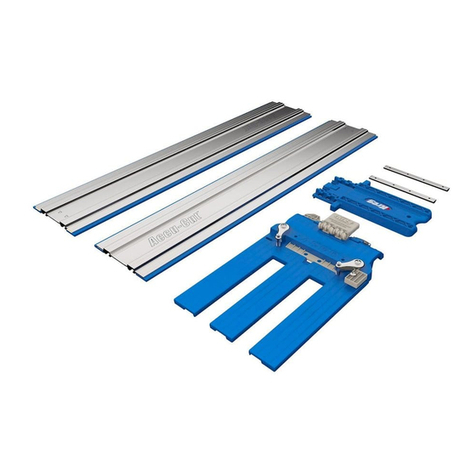
Kreg
Kreg Accu-Cut KMA2700 User manual

Kreg
Kreg 500 Series User manual
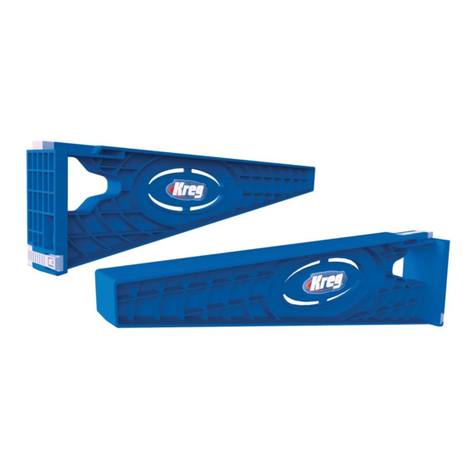
Kreg
Kreg KHI-SLIDE-INT User manual

Kreg
Kreg 700 Series User manual
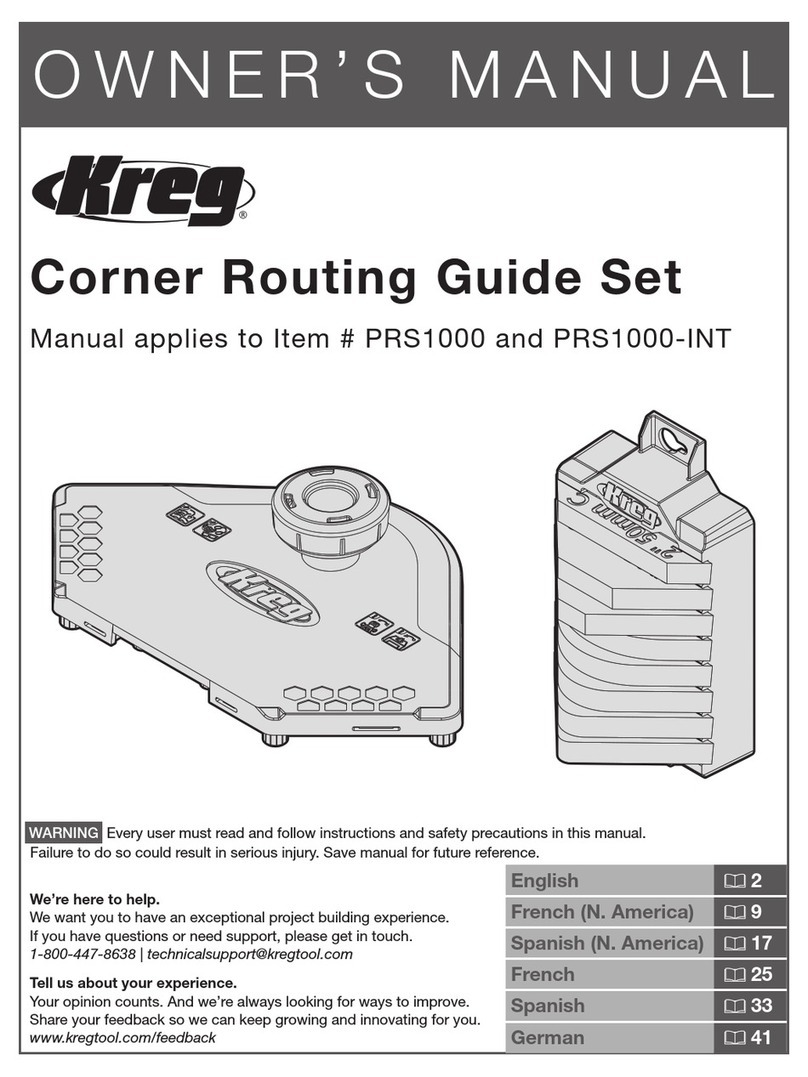
Kreg
Kreg PRS1000 User manual
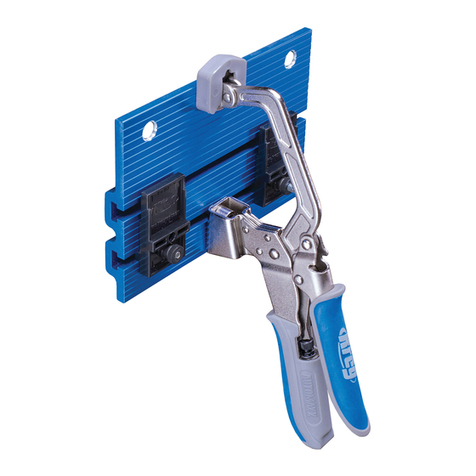
Kreg
Kreg Clamp Vise User manual
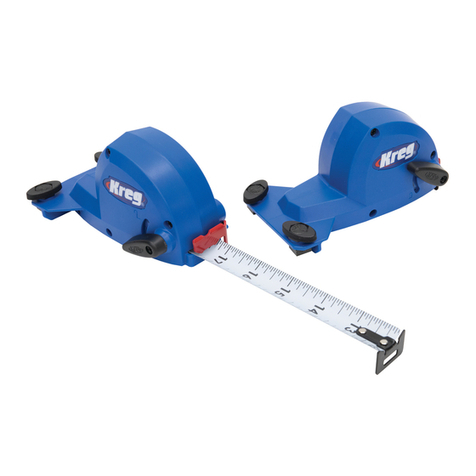
Kreg
Kreg Adaptive Cutting System Parallel Guides User manual
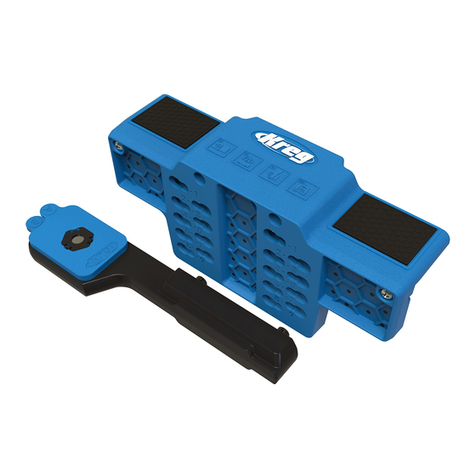
Kreg
Kreg KHI-CDIJ User manual
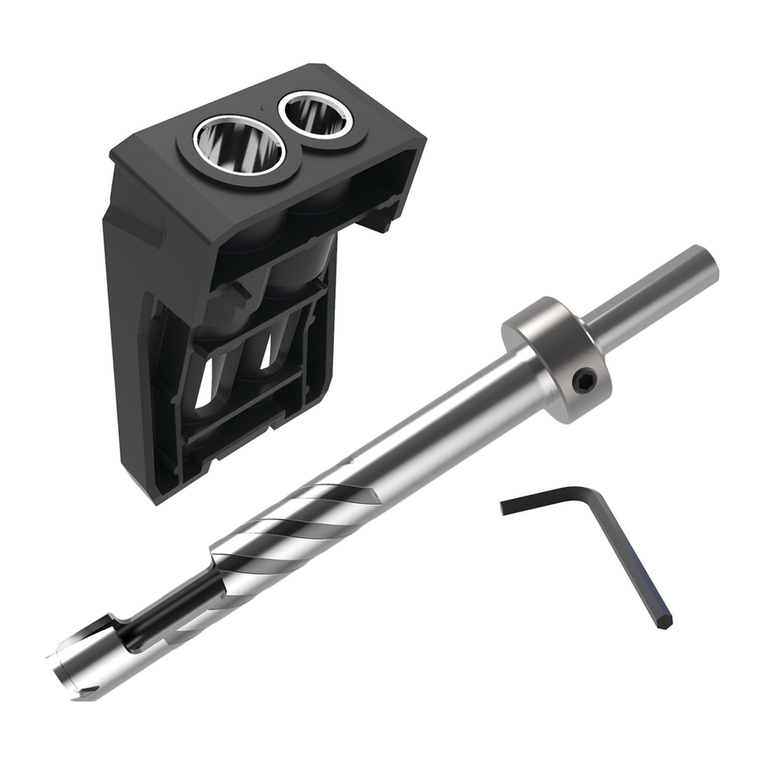
Kreg
Kreg KPHA740 User manual
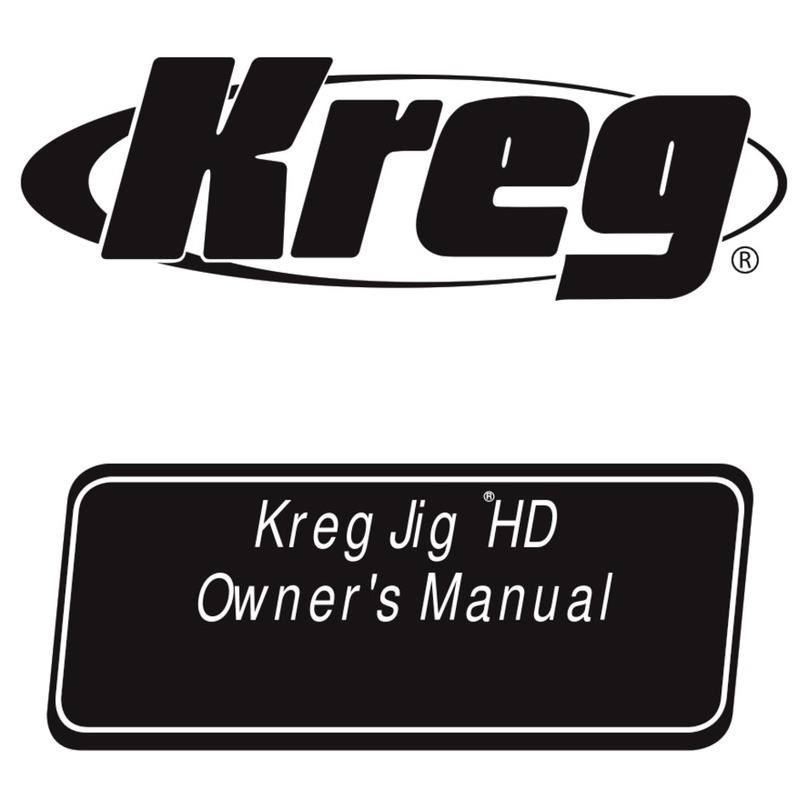
Kreg
Kreg Jig HD User manual

Kreg
Kreg Jig NK7520 User manual
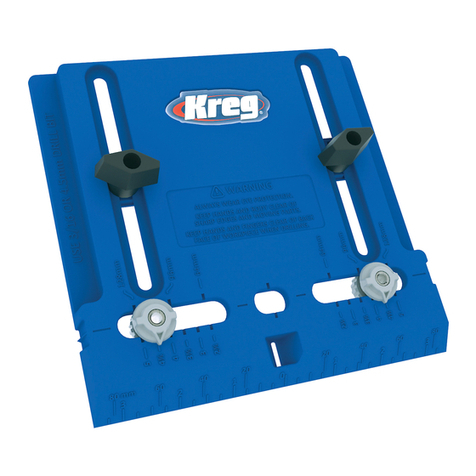
Kreg
Kreg KHI-PULL-INT User manual
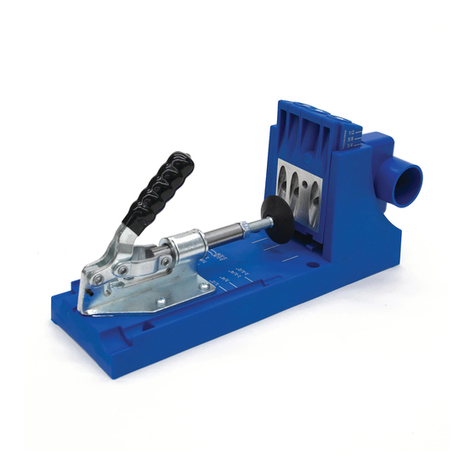
Kreg
Kreg Jig K4 User manual
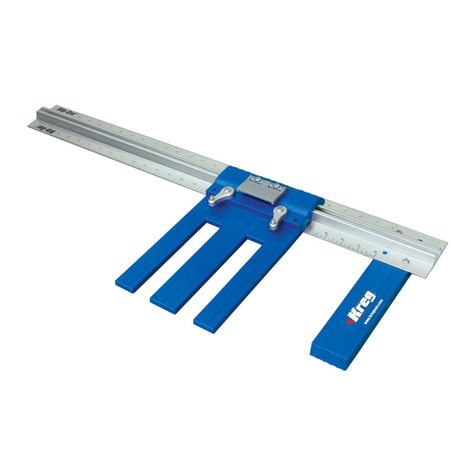
Kreg
Kreg Rip-Cut KMA2675 User manual

Kreg
Kreg KCS-DFMT User manual

Kreg
Kreg KHI-PULL-INT User manual
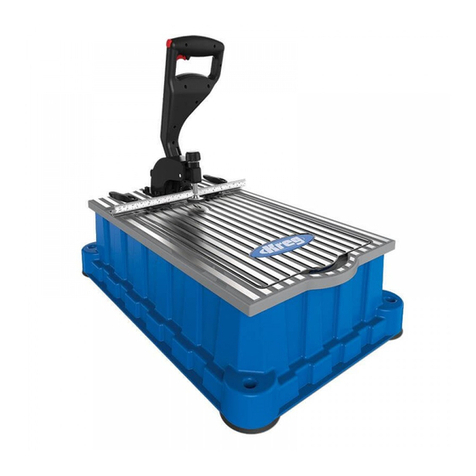
Kreg
Kreg FOREMAN DB210 User manual
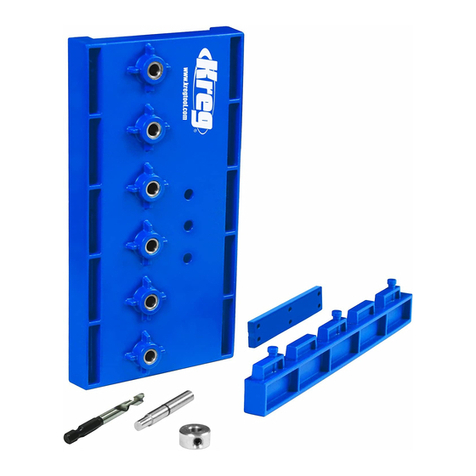
Kreg
Kreg KMA3220 User manual
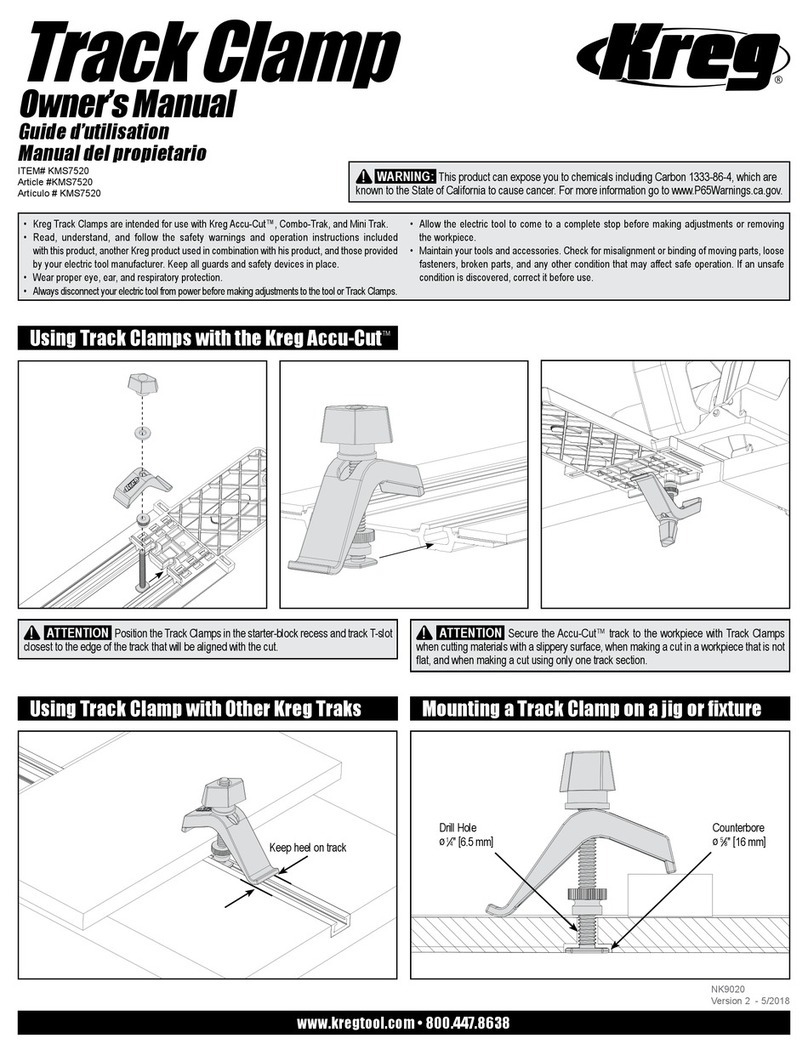
Kreg
Kreg Track Clamp User manual
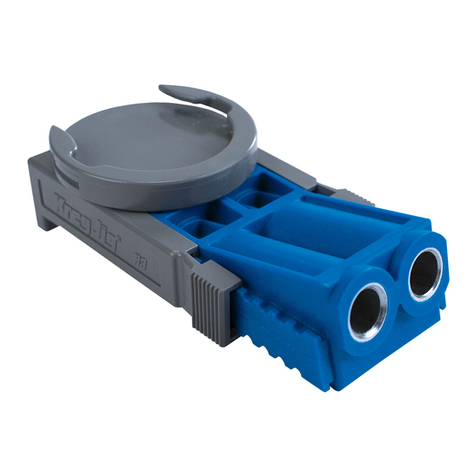
Kreg
Kreg r3 Operating and maintenance manual
